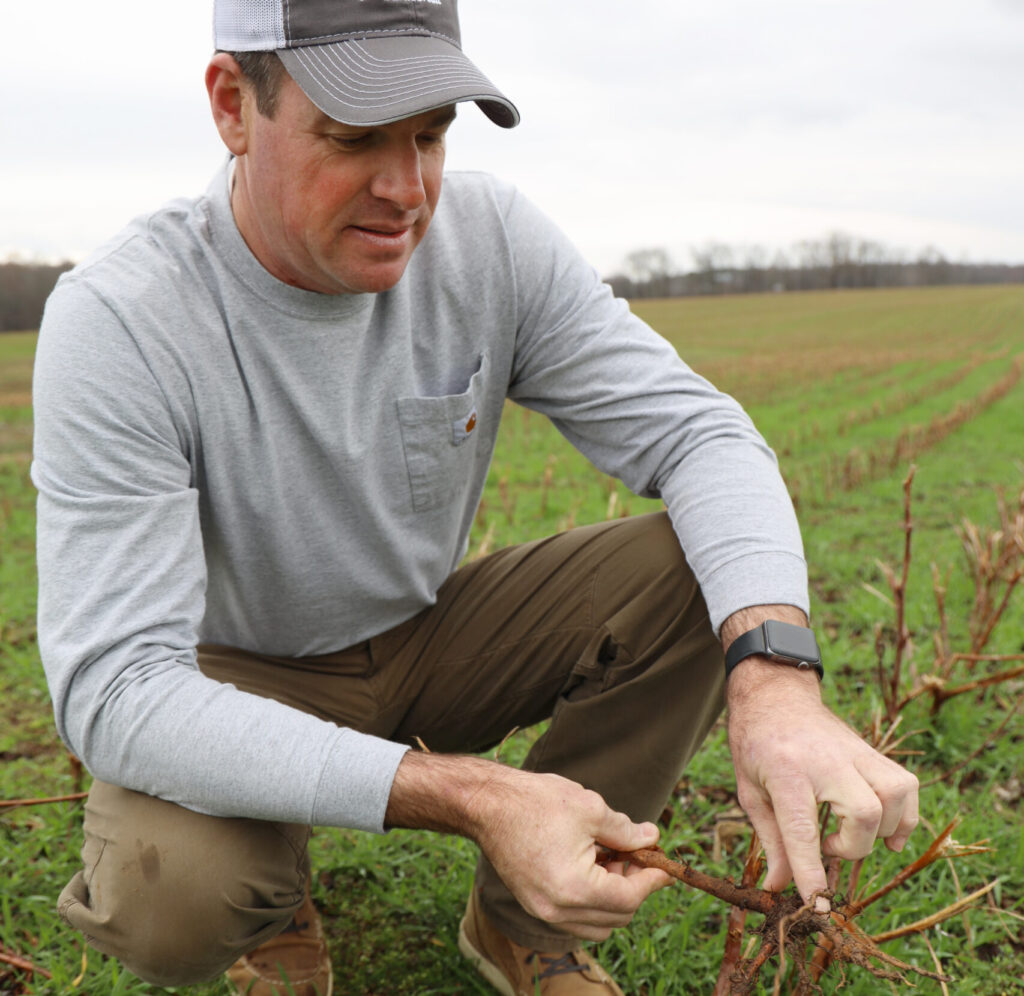Survey Says: Healthy Soils Pay Off

By Marlee Jackson
As Stan Usery Jr. pulls a chopped cotton stalk from the Limestone County soil, a treasure trove emerges.
It’s a late-winter bounty of wiggling worms, riotous roots and inches-deep organic matter. Those pay dividends for farmers like Usery, who cultivate soil health through reduced tillage, cover crops and more.
“It’s what’s underneath that counts,” Usery said. “I can’t say I’ve figured it out, but I’m going to keep trying. I think the soil health benefits are worth the effort.”
Statistics back up the anecdotal information.
Thirty U.S. farms, including three from Alabama, recently took part in a study assessing the economic impact of soil health management systems (SHMS). In addition to Usery’s farm, the Soil Health Institute (SHI) and National Association of Conservation Districts conducted the survey on Shun Binford’s farm in Limestone County and Myron Johnson’s in Henry County.

Experts found farms implementing SHMS averaged saving $14 an acre growing corn, $7 an acre on soybeans and $16 an acre for remaining crops.
Those savings seem small but could have an incredible impact over time, said Alabama Farmers Federation’s Carla Hornady.
“In today’s tough farm economy, every dollar counts,” said Hornady, the Federation’s Cotton, Soybean and Wheat & Feed Grain divisions director. “Soil health isn’t a new concept, but it’s more important than ever to really think about the impact you’re having on your soil each year.”
The study also showed an increase in net farm income and yields. Excluding the study’s lone organic farm, growers averaged $65 an acre more when they used a suite of soil health practices.
Those practices don’t just save money. They protect and improve soil.
Take cover crops.
Usery has used cover crops since the late ‘90s. Last fall, he planted 400 acres of triticale, a wheat-rye hybrid, behind cotton. That’s important considering cotton is a low-residue crop. After harvest, cotton’s minimal residue decomposes rapidly, leaving the soil vulnerable to erosion.

Triticale and other popular cover crops like cereal rye, tillage radishes and black oats grow strong root systems that help prevent washing and return critical nutrients to the soil. That organic matter builds up over time, resulting in healthier soils that could net higher-yielding crops.
Root channels also help break up the soil, which means farmers can rely less on conventional tillage, or using a mechanical implement to disc up compacted soil, before planting.
The state’s largest farm organization is forming public-private partnerships to help spread that message.
The Federation helped organize a 4R Nutrient Stewardship Field Day in February, when bright green cover crops coated fields at the Yara incubator farm in Shorter. The test site is one of five across North America and allows industry experts and Auburn University (AU) professors to trial soil health solutions.
During the event, farmers were encouraged to implement soil management techniques using the 4Rs: right source, right rate, right time and right place. Demonstrations focused on strip tilling cover crops, nitrogen management, soil fertility, nutrient stratification and irrigation sensors.
Sponsors included The Fertilizer Institute, Yara, AU’s College of Agriculture and the Alabama Cooperative Extension System.

Yara Soil Health Agronomist Curt Knight said most agronomic decisions are split in two buckets — soil degrading processes or soil conservation practices.
The former includes tillage, fallow years, soil erosion, nutrient depletion and compaction, while lauded conservation practices include cover crops, reduced tillage, crop rotation, nutrient management and surface residue retention.
Jessica Kelton is a soil health educator with SHI. During the field day, she tackled the tough question: “How can farmers quantify soil health?”
While SHMS economics research shows the impact on farmers’ bottom line, SHI is investigating regional-specific tests to measure soil health. Kelton encouraged farmers to pull samples each year in the same place. Those farmer-tested impacts include soil organic carbon and carbon mineralization potential.
Kelton hailed the importance of visual assessments, too.
Back in Limestone County, Usery gets it. He’s also practical, toeing the line of scientific evidence and logistical limits of cover crops.
“I believe in the benefits of soil health,” Usery said. “But you can’t paint with broad strokes. You’ve got to find out what works for your farm. It requires patience and trying something before you scale up.”
